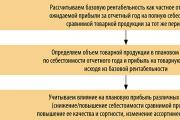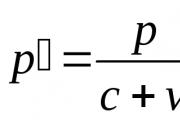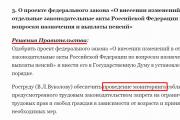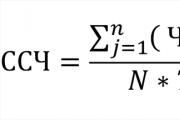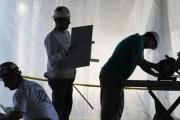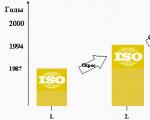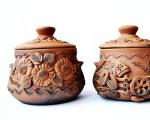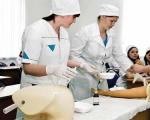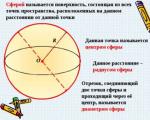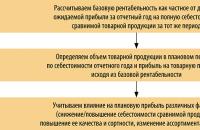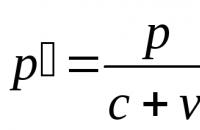Plan Plan 1. Culinary use of large-piece semi-finished products. 1. Culinary use of large-piece semi-finished products. 2. Portioned and small-piece semi-finished products. 2. Portioned and small-piece semi-finished products. 3. P\f from minced meat: 3. P\f from minced meat: chopped natural p/f, chopped natural p/f, p/f from cutlet mass. p/f from cutlet mass. 4. Culinary cutting of wild animal meat. 5. Mechanical culinary processing of offal and corned beef. Plan Plan 1. Culinary use of large-piece semi-finished products. 1. Culinary use of large-piece semi-finished products. 2. Portioned and small-piece semi-finished products. 2. Portioned and small-piece semi-finished products. 3. P\f from minced meat: 3. P\f from minced meat: chopped natural p/f, chopped natural p/f, p/f from cutlet mass. p/f from cutlet mass. 4. Culinary cutting of wild animal meat. 5. Mechanical culinary processing of offal and corned beef.

Large-piece semi-finished products are used whole for cooking, frying and stewing, as well as for the production of portioned and small-piece semi-finished products. The different culinary uses of large-piece semi-finished products are due to the unequal content and structure of connective tissue, as well as the peculiarities of the anatomical structure of the muscles of certain large-piece semi-finished products. Pork tenderloin Pork neck Pork shoulder Hind pelvic part (pork) Beef. Cutlet meat Beef. Blade part


The cutting of portioned and small-piece semi-finished products should be carried out across the muscle fibers, which contributes to less deformation of the pieces during heat treatment and easier chewing. First, portioned, and then small-piece semi-finished products are cut, allowing you to use as the latter the trimmings that are obtained after cutting portioned semi-finished products. Lumpy semi-finished products of large size are pre-cut into strips, the cross-section of which makes it possible to produce semi-finished products of certain shapes and sizes. Portioned and small-piece semi-finished products, which contain a significant amount of tight connective tissue, are subjected to mechanical processing (beating, loosening). Pork goulash Pork schnitzel Beef stroganoff

It is advisable to bread some portioned semi-finished products, which helps improve the quality and expand the range of fried meat dishes. Beaten or loose portioned semi-finished products are moistened in lezone (a mixture of eggs, salt and water) and breaded in sifted white bread crumbs.

To intensify technological processes, improve the consistency of meat containing a significant amount of connective tissue, and improve its taste, marinate with solutions of vinegar or citric acid. Prepared semi-finished products (for example, shish kebab) are poured with chilled marinade (ratio 10:1) and kept for 4 hours at a temperature of 4-60C. The marinating time depends on the content of connective tissue (for example, meat from wild animals is marinated for 1-4 days).


Name of large-piece semi-finished products Semi-finished products that are produced Large-piece Portioned Small-piece 1234 From beef Tenderloin For frying whole (roast beef) Beefsteaks, fillets, splints of beef stroganoff, meat for barbecue Dorsal part of the longissimus dorsi muscle (thick edge) For frying whole (roast beef) entrecotes, rump steaks roasted, gans Lumbar part of the longest back muscles (thin edge) For frying whole (roast beef) entrecote, roast rump steaks, beef stroganoff Upper and inner pieces of the hip part for stewing whole rump steaks, natural zrazy roasting, beef stroganoff Side and outer piece of the hip part For stewing and boiling whole dubai beef Shoulder and subscapular parts for cooking - goulash Brisket pulp for cooking whole - goulash Trim of beef of the 1st category for cooking whole - goulash Culinary use of large pieces of semi-finished products

From lamb, goat meat Loin For whole frying Natural cutlets, chops, escalopes Meat for shashlik Hip part For whole frying Schnitzels Meat for shish kebab Shoulder part For whole frying (roll) duvet lamb Meat for pilaf Brisket For stuffed frying brisket, deep-fried Stew Pork tenderloin, loin For whole frying cutting natural, natural cutlets, chops, escalopes meat for shish kebab, frying Hip part For frying whole Schnitzels Meat for shish kebab, frying Shoulder part For frying whole Brass pork Goulash Brisket For frying whole In its natural form - Homemade stew Neck part For frying whole Brass pork Goulash From veal of the first category (milk) Loin For frying whole Natural cutlets, chops, escalopes - Hip part For frying whole Schnitzels - Shoulder part For boiling and frying whole - Brisket For boiling and frying whole in natural and stuffed form Deep-fried brisket -


SEMI-FINISHED CHOPPED MEAT PRODUCTS The main raw material for their production is cutlet meat (flank, trimmings). Water is added to cutlet meat, and to some products - fillers (bread, cereal), bacon, onions, and garlic. Chopped semi-finished products are produced breaded and unbreaded.

Chopped natural p/f. Assortment: chopped beefsteak, natural chopped cutlets, natural chopped schnitzel, national products - peasant-style meatballs, Poltava cutlets, kupaty (minced meat is stuffed into soaked dry intestines, tied at the ends, shaped in the shape of a horseshoe), lula-kebab (a form of sausages), kiima-kabob (sausage shape). Assortment: chopped beefsteak, natural chopped cutlets, natural chopped schnitzel, national products - peasant-style meatballs, Poltava cutlets, kupaty (minced meat is stuffed into soaked dry intestines, tied at the ends, shaped in the shape of a horseshoe), lula-kebab (a form of sausages), kiima-kabob (sausage shape). Chopped natural p/f. Assortment: chopped beefsteak, natural chopped cutlets, natural chopped schnitzel, national products - peasant-style meatballs, Poltava cutlets, kupaty (minced meat is stuffed into soaked dry intestines, tied at the ends, shaped in the shape of a horseshoe), lula-kebab (a form of sausages), kiima-kabob (sausage shape). Assortment: chopped beefsteak, natural chopped cutlets, natural chopped schnitzel, national products - peasant-style meatballs, Poltava cutlets, kupaty (minced meat is stuffed into soaked dry intestines, tied at the ends, shaped in the shape of a horseshoe), lula-kebab (a form of sausages), kiima-kabob (sausage shape).

Cooking technology: Cutlet meat along with raw fat is ground in a meat grinder. The bacon for minced beefsteak and Poltava cutlets is cut into cubes (5 by 5 mm). The onions are finely chopped (peasant-style beatki), finely chopped (kupaty), minced together with the meat in a meat grinder (lyula-kebab, keima-kabob); the garlic is crushed (Poltava cutlets, kupaty). The components are combined according to the recipe, salt, spices, water (except for kupat, lula-kebab) are added in the amount of 8-12% of the meat mass and thoroughly mixed and formed. Breaded: natural chopped schnitzel (leison, crackers), Poltavskie cutlets (crusts), selyanski meatballs (flour). Others don't bread. Store at T=4-80C for no more than 14 hours, in that case at the enterprise where they were manufactured - 6 hours. Cooking technology: Cutlet meat along with raw fat is ground in a meat grinder. The bacon for minced beefsteak and Poltava cutlets is cut into cubes (5 by 5 mm). The onions are finely chopped (peasant-style beatki), finely chopped (kupaty), minced together with the meat in a meat grinder (lyula-kebab, keima-kabob); the garlic is crushed (Poltava cutlets, kupaty). The components are combined according to the recipe, salt, spices, water (except for kupat, lula-kebab) are added in the amount of 8-12% of the meat mass and thoroughly mixed and formed. Breaded: natural chopped schnitzel (leison, crackers), Poltavskie cutlets (crusts), selyanski meatballs (flour). Others don't bread. Store at T=4-80C for no more than 14 hours, in that case at the enterprise where they were manufactured - 6 hours.

SEMI-FINISHED PRODUCTS FROM CUTLETE MASS Assortment: - cutlets - cutlets - bits - bits - schnitzels - schnitzels - zrazy - zrazy - meatballs - meatballs - rolls - rolls - meatballs - meatballs Assortment: - cutlets - cutlets - bits - bits - schnitzels - schnitzels - zrazy - zrazy - meatballs - meatballs - rolls - rolls - meatballs - meatballs

Preparation technology: Cutlet meat is ground in a meat grinder, bread (20-25%) is soaked in water or milk, combined and passed through a meat grinder again, water (30-35%) is added, beaten, shaped, breaded. Cutlets, balls, zrazy, and schnitzels are breaded in breadcrumbs, meatballs are coated in flour, and rolls are brushed with egg, sprinkled with breadcrumbs and sprinkled with fat. In Domashnye, Kievskie, Moskovskie cutlets, raw chopped onion is also added, and in meatballs, the onion is cut and sautéed. Minced meat for rolls: boiled pasta, chopped boiled eggs, sautéed onions; for zraz: chopped sautéed onions and herbs, chopped boiled eggs. Store at T=4-80C for no more than 14 hours, in that case at the enterprise where they were manufactured - 6 hours.


Culinary cutting of wild animal meat is carried out according to schemes similar to those for cutting up domestic animal carcasses. Wild goat carcasses are like lamb, wild boar and bear are like pork, elk and deer are like beef. To improve the taste and consistency, the veined flesh of wild animals is marinated for 1-4 days before heat treatment, depending on the weight of the pieces. During the marinating process, the pieces of meat are turned over several times. Wild goat carcasses are like lamb, wild boar and bear are like pork, elk and deer are like beef. To improve the taste and consistency, the veined flesh of wild animals is marinated for 1-4 days before heat treatment, depending on the weight of the pieces. During the marinating process, the pieces of meat are turned over several times. To prepare the marinade, add salt, sugar, bay leaf, peppercorns and chopped vegetables to a 1.5-2% solution of acetic acid. The resulting mixture is boiled for minutes, then cooled and used for pickling. To increase the juiciness and calorie content, the marinated meat is stuffed with chilled pork lard, cut into cubes mm long and up to 5 mm wide. Hare meat is stewed in large pieces or chopped for stew and used to prepare cutlet mass. Natural cutlets and chops are prepared from wild goat meat. The meat of elk, deer and wild goat is used for making barbecue and frying in large pieces. Culinary cutting of wild animal meat is carried out according to schemes similar to those for cutting up domestic animal carcasses. Wild goat carcasses are like lamb, wild boar and bear are like pork, elk and deer are like beef. To improve the taste and consistency, the veined flesh of wild animals is marinated for 1-4 days before heat treatment, depending on the weight of the pieces. During the marinating process, the pieces of meat are turned over several times. Wild goat carcasses are like lamb, wild boar and bear are like pork, elk and deer are like beef. To improve the taste and consistency, the veined flesh of wild animals is marinated for 1-4 days before heat treatment, depending on the weight of the pieces. During the marinating process, the pieces of meat are turned over several times. To prepare the marinade, add salt, sugar, bay leaf, peppercorns and chopped vegetables to a 1.5-2% solution of acetic acid. The resulting mixture is boiled for minutes, then cooled and used for pickling. To increase the juiciness and calorie content, the marinated meat is stuffed with chilled pork lard, cut into cubes mm long and up to 5 mm wide. Hare meat is stewed in large pieces or chopped for stew and used to prepare cutlet mass. Natural cutlets and chops are prepared from wild goat meat. The meat of elk, deer and wild goat is used for making barbecue and frying in large pieces.
 Frozen offal is defrosted in air in the meat shop at t=15-18C. Brain, kidneys, scars can be thawed in water. Then the by-products are processed. The brain is soaked in cold water for 1-2 hours to allow the film to swell. The film is removed without removing the brain from the water. Waste %. Frozen offal is defrosted in air in the meat shop at t=15-18C. Brain, kidneys, scars can be thawed in water. Then the by-products are processed. The brain is soaked in cold water for 1-2 hours to allow the film to swell. The film is removed without removing the brain from the water. Waste %. Beef brain The blood vessels are cut out from the liver, then it is washed in cold water and the film is removed. Waste – 12-17%. Beef liver
Frozen offal is defrosted in air in the meat shop at t=15-18C. Brain, kidneys, scars can be thawed in water. Then the by-products are processed. The brain is soaked in cold water for 1-2 hours to allow the film to swell. The film is removed without removing the brain from the water. Waste %. Frozen offal is defrosted in air in the meat shop at t=15-18C. Brain, kidneys, scars can be thawed in water. Then the by-products are processed. The brain is soaked in cold water for 1-2 hours to allow the film to swell. The film is removed without removing the brain from the water. Waste %. Beef brain The blood vessels are cut out from the liver, then it is washed in cold water and the film is removed. Waste – 12-17%. Beef liver

The kidneys are freed from fat along with the film (beef) or a layer of no more than 5 mm is left (veal, pork, lamb). Beef kidneys are cut halfway through on one side and soaked in water for 2-3 hours, changing it several times. Lamb, pork and veal kidneys are not soaked. Waste – 10-14%. Beef kidneys Tripe are first soaked in cold water for 6-9 hours, changing it, then scalded several times and washed again with cold water. Waste – 5%. Waste – 5%. The scars are first soaked in cold water for 6-9 hours, changing it, then scalded several times and washed again with cold water. Waste – 5%. Waste – 5%. Tripe Scar


Corned beef (salted meat, dried) contains 6-12% salt. So that corned beef can be used for food, the salt content is reduced to 2-3%. To do this, it is cut into pieces weighing 1-1.5 kg and filled with cold water at the rate of 2 liters per 1 kg of corned beef. The water must be changed 1, 2, 3, 6, 12 hours after the start of soaking.

Plan: 1. Characteristics and nutritional value of raw materials. 2.Mechanical culinary processing of poultry and game in enterprises that use raw materials. 3. Production of semi-finished products. 4.Manufacture of products from cutlet and dumpling mass. 5.Centralized production of semi-finished products. 6. P/f from rabbit. Plan: 1. Characteristics and nutritional value of raw materials. 2.Mechanical culinary processing of poultry and game in enterprises that use raw materials. 3. Production of semi-finished products. 4.Manufacture of products from cutlet and dumpling mass. 5.Centralized production of semi-finished products. 6. P/f made of rabbit.

The bird arrives at the processing facility different types(chickens, hens, ducks, geese, turkeys) Poultry arrives at the processing facility of different types (chickens, hens, ducks, geese, turkeys) - first and second categories of fatness, - cooled, chilled or frozen, - gutted or semi-gutted. In semi-gutted carcasses, feathers, intestines, and blood have been removed; and in the gutted ones - everything internal organs, head, neck, paws.


Poultry meat contains proteins, fats, vitamins, minerals and extractives, water, and is highly valuable food product. The content of basic substances depends on its fat category, type and age. There is significantly less fat in the meat of young poultry and game than in the meat of adults. Poultry meat of different species differs significantly in chemical composition. Thus, high protein content is typical for turkey meat (19-21%) and chicken (18-21%), fat content is typical for geese and duck meat (24-39%). Game meat contains more proteins (23-25%) and less fat (1-2%), with the exception of quail (proteins-18%, fats-18.6%). Chicken and turkey meat is lighter in color than waterfowl meat. The color of the muscle tissue of chickens and turkeys is different: the breasts and wing muscles are white, while others are dark red. The color of the muscles of waterfowl does not depend on location. The nutritional value of white meat is higher than red meat due to its higher protein content and a more favorable ratio between complete and incomplete proteins. Dark meat has more fat than white meat. Poultry meat contains less connective tissue proteins than meat from slaughtered animals.


1. Defrosting. In a cooled room at T=8C and relative air humidity of 90-95% for an hour. Feathers are removed from thawed game carcasses by plucking, starting from the neck. To avoid damaging the skin, it is slightly pulled back. 2. Searing. Using a gas torch on a flexible hose. Game is singed only when, after plucking, lint and fine fluff remain. The stumps are removed with tweezers. 3. Removal of heads, necks and paws. The head is cut off at the second cervical vertebra. Before removing the neck, a longitudinal incision is made in the skin from the back, then the skin is shifted, the neck is freed and it is cut off, 5-6 cm of skin is left to cover the cut site. After this, the esophagus, trachea and crop are removed. For small game - snipe, great snipe, woodcock - the heads are not cut off, but the skin is removed from them and from the neck and the eyes are removed. Then the wings are cut off at the elbow joint and the paws are cut off 1-2 cm below the knee joint. 4. Gutting. In a semi-gutted bird, the internal fat (omentum), liver with gall bladder, stomach, heart, kidneys, lungs, spleen, ovaries, oviduct are removed; in a gutted one - omentum, lungs, kidneys. Gutted through a hole in the abdominal cavity from the anus to the keel of the sternum. To gut small game, cut the neck from the back. Pieces of carcasses soaked in bile are cut off.


Chickens, chickens, turkeys are tucked into two threads, which are fried; for boiling, this bird is tucked into a pocket. Game (except small ones) is tucked into one thread; geese, ducks, turkeys, tucked into a pocket. Small game is dressed without twine. In quails, an incision is made on one leg, closer to the knee joint, between the bone and the tendon and the second leg is inserted into it. Grouse, black grouse, wood grouse, pheasants are tucked into one thread. The meat of black grouse, wood grouse, pheasants, and partridges is not juicy enough, so it is stuffed after seasoning. Before stuffing them for 3-5 minutes. immersed in hot water (60-70C), which facilitates the stuffing process by compacting the fabric and improves appearance carcasses. The main product is a cut-up and processed carcass. It is used entirely for cooking and frying, as well as for making semi-finished products for poaching, stewing and frying. 6. Processing of offal. The gallbladder is cut off from the liver along with a small part of the liver tissue so as not to damage the bladder. The cuticle of the stomach is removed. To do this, the stomach is cut in the middle, turned inside out, and then the cuticle is removed. The heart is cut open and freed from blood clots. Giblets (except liver) are washed in cold water, no higher than 15C. Poultry food waste includes heads, necks, feet, combs, wings, livers, gizzards and hearts; Only necks are included in game food waste.



In chickens, much less in pheasants, hazel grouse, grouse and partridges, fillets are removed to make cutlets and schnitzels (natural). The carcasses are placed with their backs on the table, cuts are made in the flanks and the skin is removed from the pectoral muscles, then they are cut off from the breast bone and cut clavicle and remove the right and left muscles (fillet) along with the humerus bones; the removed pectoral muscles are cleaned. In this case, the inner muscle (small fillet) is separated from the outer muscle (large fillet). The tendon is removed from the small one, and the remainder of the clavicle is removed from the large one. The humerus is cleared of pulp and tendons and shortened to 3-4 cm, cutting off approximately half of the head of the shoulder joint. Next, the film is cut from the large fillet, and inside 1-2 small oblique cuts are made lengthwise and the fillet is unfolded so that its tendon is exposed inside, which is cut in 2-3 places, after which the fillet is shaped.

Fillet cutlets are made stuffed and unstuffed. For poultry fillet cutlets, butter (Kiev cutlets) or thick milk sauce is used as minced meat, and for game fillet cutlets, pate or dumpling mass is used. Unstuffed cutlets are made natural or breaded, stuffed cutlets are made only breaded.

To make stuffed cutlets, the cleaned large fillet is cut lengthwise, turned in both directions, then lightly beaten with a hoe to a thickness of 2-3 mm and trimmed in 2-3 places. Chopped pieces of meat cut from small fillets are placed on the cuts. Place cooled minced meat in the middle of a large fillet, cover it with small beaten fillets, and fold the edges of the large fillet, giving the cutlet a rounded pear-shaped shape. The cutlets are sprinkled with salt, dipped in lezone and breaded in bread crumbs. Kiev cutlets are breaded twice so that the oil does not leak out during frying. In addition to fillets, we get legs, wings (fried), trimmings (for cutlet mass) and frames (for cooking broths).
 The pulp of chickens, turkeys and big game is used. The technology for producing cutlet mass is the same as for making meat from slaughtered animals, only butter and oil seal are added. The products are cutlets and meatballs, but less than meat. The technology for producing dumpling mass is the same as for making fish. Used for stuffing game fillet cutlets and making dumplings of various shapes as a side dish for clear soups.
The pulp of chickens, turkeys and big game is used. The technology for producing cutlet mass is the same as for making meat from slaughtered animals, only butter and oil seal are added. The products are cutlets and meatballs, but less than meat. The technology for producing dumpling mass is the same as for making fish. Used for stuffing game fillet cutlets and making dumplings of various shapes as a side dish for clear soups.

Rabbit meat comes in fatness categories 1 (75% pulp) and 2 (70% pulp). Rabbit meat is a high-value protein product (21% protein), fat – 13%. It contains B vitamins, minerals and extracts. During machining The carcass' mark is cut off, the neck, cervical vertebra, and kidneys are removed, after which the carcasses are cleaned and cut into 2 parts - the front and back along the last cervical vertebra. The pulp of the back part contains little connective tissue, which is why natural cutlets and stuffed (with milk sauce) cutlets are made from it. The front part is used for stewing. Products from cutlet mass (cutlets, meatballs) are also made from rabbit meat. Prepared rabbit carcasses are used completely (boiling, frying) or for preparing portioned (natural cutlets, stuffed cutlets, capital-style rabbit), small-piece (stew, pilaf, amateur rabbit) and chopped (cutlets, meatballs) semi-prepared the same technology used to produce semi-finished products from poultry.

2. Classification
Poultry dishes
Poultry dishes
Boiled
- carcass
entirely
Steamed
- fillet
- hip
- shin
- dumplings
For a couple
- dumplings
- fillet
- hip
- shin
entirely
Fried
main
way
Feathered game dishes
Stewed
portioned
mi
in pieces
small
in pieces
portioned
in pieces
Zapeche
data
- fillet
Frying
- entirely
- portioned
in pieces
Extinguishing
- portioned
in pieces
small
in pieces 3. Processes in poultry, game, and rabbit meat during heat treatment
1. Pressing out moisture
Muscle proteins → denaturation → weight loss of 25-28% (loss of mineral,
t 60 C and above moisture loss
(dehydration)
extractives) Processes in poultry, game, and rabbit meat during heat treatment
2.Rendering fat
Fat → loss during cooking is 30-35%
→ when frying, losses are 40-45%
rendering 3.Tenderizing poultry meat
t 90 C and above
Collagen
destruction
glutin
(softening
fabrics)
4. Formation of new tastes
substances 4. Quality requirements and rules for selecting semi-finished poultry products
Semi-finished products must be correct
shape and method of cutting, without breaks
skin, stumps on the surface.
The consistency is elastic, not flabby.
The surface is slightly damp, without mucus.
The color is white-pink.
The smell is characteristic of fresh poultry. Not
putrid, sour. 5. Options for combining poultry with other ingredients
Non-starchy and green vegetables:
parsley, dill, celery; tops
radishes, beets; salad, wild "table"
herbs, white cabbage, green and
onions, garlic, cucumbers, eggplants,
bell pepper, green peas.
Radish, rutabaga, radish and turnip
Starchy vegetables - beets, carrots, horseradish,
parsley and celery roots, pumpkin,
zucchini and squash, cauliflower.
From cereals - rice. 7. Rules for selecting spices and seasonings to create harmonious dishes from boiled poultry
For poultry: curry, turmeric, nutmeg
walnut, star anise, thyme, marjoram, rosemary,
sage, basil.
For game: thyme, oregano,
allspice, red pepper,
juniper 8. Methods for preparing poultry for complex dishes
steaming and “vegetable pillow”,
allowance,
grilling,
frying in a wok,
spit roasting,
stewing with and without garnish,
languishing in pots,
smoking,
baking. Options for combining different methods of preparing complex dishes:
molding
stuffing
glazing
grinding Glaze
– from German glasieren –
glaze, create
shiny glossy surface.
Most often covered with glaze
confectionery products, pouring them
chocolate or special
prepared sugar mass.
However, glaze is also used
to add shine and create
beautiful glossy surface
vegetables, poultry, meat, etc. In this
case for glazing
use honey, fruit juices and
syrups. 9. Boiled poultry dishes
Rules for boiling poultry
Chickens and chicks are used, less often - geese and ducks
Seasoned poultry carcasses are boiled whole. They are placed in hot water
(2.5 l of water per 1 kg of product), quickly heat to a boil, remove
foam, add roots, onions, salt and cook at 85-90°C until
readiness.
Cooking time for chickens is 20-30 minutes, for young chickens - 50-60 minutes, for old ones
- 3-4 hours, geese and turkeys - 1-2 hours, game - 20-40 minutes.
Sauce - white with egg. Side dish - fluffy rice, mashed potatoes
or boiled potatoes, green peas. Served with goose or duck
red sauce, because dark meat. Side dish – stewed cabbage, baked
apples, pickled vegetables. Boiled poultry dishes
Boiled turkey
Poultry with steam sauce
Natural poultry fillet cutlets
steam sauce with mushrooms
Boiled rabbit (sauce - sour cream with
onion or tomato with wine)
Poultry quenelles
using SOUS technology
VIDE technology low
temperature
cooking
(vacuum,
low temperature
thermal bath)
Wash and clean
boil mushrooms,
cut Chicken leg stuffed with stitches
Separate the bone from
meat, carefully
so as not to tear the skin Chicken leg stuffed with stitches
Clean the pit and
cut off carefully With butter
fry parey onion
and mushrooms, with
Provencal herbs
and ground pepper
We spread the food
film on the board,
lay out the leg Chicken leg stuffed with stitches
The bone is inserted
out through the hole
Cut a little
meat, salt, pepper, and
stuffed with mushrooms and
pieces of butter
oils, mold
Salt and pepper on top, and
sprinkle with Provençal
herbs. Wrap up
in the first layer of film Chicken leg stuffed with stitches
Twist the film
rolling tightly
roll
They tie it up and
roll up tightly
several layers
films, vacuum
and boil in
low temperature
thermobath 2 hours at
65 C Chicken leg stuffed with stitches
Sauce: Fried
lines and
champignons, finely
chopped, with
demiglass.
Add red
wine, provencal
herbs and boil
sauce. Poultry quenelles
10. Fried poultry and rabbit dishes
Rules for frying poultry carcasses
Carcasses of chickens, chickens, broiler chickens, turkeys, geese,
ducks, rabbits are rubbed with salt, placed back down on
a baking sheet heated with fat to 150C and fried
on the stove until a crust forms over the entire surface
carcasses. Rules for frying poultry carcasses
Fried carcasses are placed in a frying pan
cabinet (temperature no more than 200°C) for 15
min to finish cooking.
The carcasses of large turkeys, geese, and ducks are salted.
Low-fat poultry is greased with sour cream, fatty poultry
pour over hot broth. Baking trays with poultry
place in the oven for 10 minutes at 200-
250°C, then the temperature is reduced to 160°C. Rules for frying large poultry carcasses
Carcasses of old chickens, geese, ducks, turkeys
Before frying, it is recommended to boil until
half-ready. Roast poultry before serving
the table is cut into portions. In the beginning
separate the wings and legs, then the side
part, after which the carcass is divided in half into
transverse direction and cut these
halves per serving.
Place chopped pieces of poultry on a plate
so as to give them the shape of a whole carcass. Roasted duck breasts
Do
cruciform
cuts.
Salt the breasts and
pepper both
sides Roasted duck breasts
The blunt side of a knife
remove moisture from the breast,
formed under
exposure to salt. If we
we won't do this, skinny
fry too much.
Place duck breasts on
heated frying pan with skin
down. Preferably a frying pan
with a removable handle
can be put in the oven.
Place the frying pan on
strong fire. Roasted duck breasts
Fry the breasts for
high heat until
brown crust with
two sides. Roasted duck breasts
Turn the breasts over again
skin side down and place in
preheated to 200
oven at 10 degrees
minutes.
After 10 minutes, take it out
breasts from the oven and immediately
transfer to a plate.
Leave to rest for 1-2
minutes. Roasted duck breasts
In a couple of minutes
cut the breasts
slices no thicker than 1
cm. Duck with dates and sea buckthorn
Duck fillet 150, sugar 40,
sea buckthorn 30, ginger 5,
dates 60. water 30, wood chips
alder 10, rhubarb 40, salt
floral 3 Duck breast 250, dry white wine
70, port 70, butter 30,
sugar 30, salt, black pepper
ground, orange chips 10,
daikon sprouts 30 Banquet serving of duck
Roast goose with apples
Salt the prepared goose
stuff with apples
cored and
cut into slices. Hole
sew up in the abdomen. In this form
put the goose on its back
frying pan, add 0.5 cup
water and put it in the oven
frying. While roasting a goose
needed several times
pour over the rendered fat and
juice Roast the goose should be 1.5 -2
h.
Remove the threads from the finished goose,
take out the apples with a spoon and place
put them on a plate, chop the goose and
put it on the apples. Fried poultry dishes
Dish names
Game fried in
sour cream sauce
Chickens
Tobacco No. 459
Goose, duck
stuffed
№ 451
Rabbit by –
capital no.
456
Cutlets
stuffed
View
semi-fa
bricate
Compound
recipes
s
Way
thermal
processing
Garnish
Innings Titles
dishes
View
semi-finished product
Compound
recipes
Way
thermal
processing
Garnish
Innings
Tobacco chickens
Spread out
carcass
Salt, garlic,
sour cream
Frying for
frying pan under
press
Tomato
ry,
green
onion,
lemon
Whole or
cut
half and half, sauce
tkemali or
chiseled
garlic
Game fried in
sour cream sauce
Portion. Pieces
hazel grouse,
partridges,
black grouse,
pheasant, capercaillie
Sour cream sauce
Frying
porion.
pieces,
warming up in
sauce
Heat
ny
potatoes
Sauce
sour cream
Cutlets
stuffed
Cutlets from
poultry fillet
Minced meat: mushrooms,
milk sauce
Deep fried
until ready
– fryer
closet
Carto
fel
fried
th in
deep fried
,
green
peas
On croutons
watered sl.
oil Sauce
red with
wine Chicken Kiev
Thawed, washed
put the chicken on its back
chop off the wings to
it was more convenient to separate the breast from
bone. To get two
chicken breast fillet
follow the bone with a sharp knife
gently draw along
ribs to separate the fillet from
two sides. In this case it is necessary
cut off the breast along with
humerus. Chicken Kiev
We get two breasts per
bones and some other small ones
piece of fillet with inner
sides of each piece.
Remove skin from fillet.
Put them inside
side up. Notch
fillet from the middle along both sides
sides and spread each
piece so that it fits
filling. Then you need the fillet
beat it off carefully. Chicken Kiev
Place in a small container
chopped parsley
with melted soft
butter and salt.
Mix thoroughly until
obtaining a homogeneous mass.
Hem (or prune)
white tendons in several
places so that the cutlets do not
cringed in the process
preparations. Chicken Kiev
Using two canteens
spoons make two shapes from
oils Put it in the freezer
for 3-5 min. This is necessary in order to
to form from soft butter
didn't blur.
Remove from freezer
place on fillet. Wrap
cutlet using small
fillet pieces. Chicken Kiev
Bye cutlets
freeze 3-5
min. in the freezer, you need
take the prepared
container, break two in there
eggs. Pour out the milk. WITH
use a whisk to make
leison.
Remove cutlets from
freezers. Chicken Kiev
Then follows
pepper the cutlets and
roll them first in
wheat flour
bread, then in egg with
milk. Chicken Kiev
Roll the cutlets in
breading. Then again
dip them in leison and
again in breading.
Double breading needed
in order for the crust
Kyiv cutlet was
firmer, crispier
and did not fall apart when
frying Chicken Kiev
Place the finished cutlets on
cutting board. Carefully
press down the breading so that it
did not fall off the cutlets. If
it will seem like a crust
not dense enough again
dip the cutlet into the leison and
crackers. Pour into a container for
deep fry the oil and heat until
200° C (when
bubbles). Also reheat
oven to 200° C. Chicken Kiev
Then take turns
fry the cutlets in
frying oil until
golden crust
(about 5 min.), after
what to bring them to
ready in the oven
for 10 minutes. Chicken Kiev
Can be submitted to
croutone.
Garnish - green
peas, potatoes
deep fried,
complex side dish
Drizzled with creamy
oil How to eat “Cutlet Kiev”:
How to eat “Cutlet Pokievski”:
1. Before you start eating the cutlet, make a small puncture
with a fork to let the oil drip onto the garnish.
2. To prevent the oil from splattering, you should pierce the cutlet completely
next to the bone.
3. After the oil has flowed out, start eating the cutlet, carefully
cutting pieces from it with a knife - from left to right.
Bon appetit! Stuffed wings
Soak large ones
chicken wings on
2 hours cold
water. Stuffed wings
Minced meat: pass through
chicken meat grinder.
Sauté the onion and
carrot. Add finely
sliced sweet
red pepper,
saute for another 3-4 minutes.
Season with cumin
paprika, salt and pepper
red, remove from heat and
cool.
Mix prepared
minced chicken with vegetables. Stuffed wings
Break every one
wing in joint
(without damaging the skin).
Peel off chicken skin
fingers and
gradually separate
her from meat to
broken
joint
Turn the skin up
rolling it up like a sleeve. Stuffed wings
Cut off the pit from
meat and continue
separate and roll up
skin until next
joint. Also
cut off the bone from
meat. Stuffed wings
The skin will remain -
pocket with
last joint
wing
Cut the meat off
seeds, chop and
add to minced meat.
Mix. Stuffed wings
Tight
stuff
wing pockets,
wrap the edges,
chip with a toothpick
or sew, salt,
pepper and grease
olive oil. Stuffed wings
Lay down
stuffed wings
to oiled
olive oil
baking tray
Roast in the oven at
temperature 195
degrees, periodically
turning over until
readiness.
Ready wings
put on a dish
Wash the wings
dry, cut
first phalanx. Chicken wings in sweet and sour soy sauce
Mix: soy sauce,
red balsamic,
honey, mustard,
olive oil,
Tabasco.
Add finely
chopped garlic,
ginger, celery,
pepper. Chicken wings in sweet and sour soy sauce
Marinate the wings
minutes for 30 minutes.
Bake in the oven at 180C
30 minutes, time from
time watering them
marinade.
On the juice from frying
prepare the sauce: reduce
double the liquid
lemon juice or
balsamic, salt and pepper.
Strain the sauce.
Serve with spaghetti and
sauce Introduction
Industrial training– the most effective method of instilling practical skills in students. One of the main tasks of the industrial training master is to instill in students a careful attitude towards raw materials, inventory and equipment in production. To make the on-the-job training process most effective and interesting, the master must prepare thoroughly.
Goals of the open lesson:
- During the lesson, each student must acquire practical skills and abilities in processing poultry and game and preparing semi-finished products from them.
- During the lesson, each student must learn to correctly calculate raw materials when preparing semi-finished poultry and game products, and be able to use a collection of recipes.
Lesson progress
After the organizational part, conduct a survey of students on the topic outlined above. Remind the safety rules when working with a knife. If necessary, explain and show the types of semi-finished poultry and game products. Remind students about the conditions and terms of their storage. Draw students’ attention to the quality requirements for semi-finished poultry and game products. Ask students questions to consolidate the information received. Students write down the purpose, technology, cooking process, weight of the semi-finished product and the yield of the finished dish.
Place students at work stations, distribute task cards with individual tasks for each student. Check the organization of workplaces, the availability of equipment, utensils, as well as the sanitary condition of the places. Provide practical assistance to students in their work. Ensure that work procedures are performed correctly and that safety regulations are followed. Explain to students possible types errors and defects in the preparation of semi-finished products. Monitor compliance with sanitary rules when working with raw materials and products during work.
Main part of the lesson
To prepare semi-finished products from poultry and game fillets, you need to remove and clean the fillets. The processed bird or game carcass is placed on its back with the legs facing towards you, the skin and flesh in the flanks are cut, the legs are pulled back and placed on a cutting board.
Remove the skin from the pectoral muscles. Then they turn the carcass over with the chest part facing you, cut the muscle on one side of the bone along the protrusion of the breast bone with a sharp knife, cut the bone with the frame, and remove one fillet. After this, the muscle on the other side of the breast bone is trimmed and the other fillet is also cut off.
The resulting fillet is cleaned. To do this, separate the inner muscle (small fillet) from the outer muscle (white fillet). The tendon is pulled out of the small fillet and the flesh is beaten. In a large fillet, the fork bone is removed, the shoulder bone is cleared of pulp and tendons, it is shortened, leaving 3–4 cm, and the thickened part of the bone is cut off (mak lachok).
Then the fillets are moistened in cold water, placed on a board with the inside facing up and the outer film cut off. After this, longitudinal cuts are made in the large fillet and the fillet is opened.
The following dishes are prepared from poultry and game fillets: “Chicken in the capital style”, “Pheasant in the capital style”, natural cutlets, breaded cutlets, Kiev cutlets (see Table No. 1. Semi-finished products from poultry and game fillets).
The instructional and technological map of the dish “Poultry, game in the capital” is presented in Appendix 1. The instructional and technological map of minced poultry or game fillet cutlets with garnish is presented in Appendix 2.
Table 1
Semi-finished products from poultry and game fillets
| “Poultry or game in the capital” (Schnitzel capital) |
The shoulder bone of a large fillet is cut off, the fillet is cleaned and opened. Then lightly beat it, cut the tendons in 2-3 places, place a small fillet on it and cover it with the edges of a large fillet, giving it an oval shape. Soaked in lezone, breaded in a breading of stale wheat bread without crusts, cut into strips.
|
| Natural cutlets |
In a large, cleaned and opened fillet with a bone, the tendons are cut in 2-3 places. A small fillet is inserted into the cut, the edges of the large fillet are tucked into the middle, covering the small fillet, and given an oval shape. |
| Breaded cutlets |
The semi-finished product is prepared as for a natural cutlet, then dipped in lezone and breaded in white breading. |
| Chicken Kiev |
A large, cleaned and opened fillet with a bone is lightly beaten, the tendons are cut, and beaten pieces of flesh cut from a small fillet or trimmings from a large fillet are placed on the resulting cuts. Place cooled butter, formed into sausages, in the middle of the prepared fillet, cover the top with the remaining small fillet and wrap the large fillet. Then they are dipped in lezone, breaded in white breading, again moistened in lezone, again breaded in white breading and stored in the refrigerator until frying so that the butter is frozen.
|
Chickens, turkeys, hazel grouse, black grouse, partridges, wood grouse and pheasants are used for cutlet mass. From poultry carcasses, fillet pulp and legs are used, and from game carcasses (except pheasants and partridges) - only fillet. The pulp is separated from the bones and skin, passed through a meat grinder along with the internal fat, bread without crusts soaked in milk and salt are added, mixed well and passed through the meat grinder again, then knocked out. You can add ground pepper to the game cutlet mass. Internal fat can be replaced with butter or margarine. From the poultry cutlet mass the following are prepared: cutlets, Pozharsky cutlets, meatballs, chopped poultry meatballs stuffed with champignons, zrazy, meatballs (see Table No. 2. Semi-finished products from cutlet mass from poultry and game meat).
Table 2
Semi-finished cutlet mass products from poultry and game meat
| Cutlets
|
The cutlet mass is portioned, white-breaded, and shaped into cutlets. |
| Pozharsky cutlets
|
The cutlet mass is cut into 3–4 pieces. per serving, breaded in figured breading (small cubes or strips) and given an ovoid-flattened shape. |
| Beats
|
The cutlet mass is portioned, coated in white breading, and shaped into meatballs. If the meatballs are steamed, they are not breaded. |
| Chopped poultry balls stuffed with champignons
|
The cutlet mass is portioned, shaped into a circle 1 cm thick, finely chopped boiled champignons are placed in the middle, the edges are joined, breaded in white breading, and shaped into meatballs. |
The final part of the lesson
Summing up the work:
1) Announcement of grades of students who took part in the preparation of semi-finished poultry and game products.
2) Analysis of mistakes made during work, ways to eliminate them.
3) Mark students who showed obedience, accuracy, hard work, and resourcefulness in their work.
4) Inform students about the topic and content of the next lesson.
5) Give homework: “Reinforce the material covered. Prepare an algorithm for preparing semi-finished poultry and game products yourself.”
After completing work, students must clean up their workplaces, which complies with personal hygiene standards and the rules for conducting practical classes.
One of the most important tasks of the master is to develop students’ independence in performing elements labor process. At the initial stage of training, great help is provided technological maps, where self-control issues are listed in a separate column.
In order to stimulate thinking and increase the feeling of satisfaction from the work process, the master needs to direct the mental activity of students in such a way that their thinking process is always a search process. It is very important that the teacher pays attention to all sorts of attempts by students to invent and try something of their own and encourages them.
Bibliography:
- Androsov V.P., Pyzhova T.V., Ovchinnikova L.V.. “Industrial training for the profession “Cook”/Part 3. Cooking cold dishes and snacks”/Tutorial. – M.: “Academy”, 2007, –128 p.
- Anfimova N.A.. "Cooking." /Text. guide for beginners prof. education – M.: “Academy” – 2011, – 328 p.
- Dubrovskaya N.I.. “Cooking. Laboratory workshop". – M.: “Academy” – 2011, – 240 p.
- Zolin V.P.. « Technological equipment enterprises catering" /Textbook for primary vocational education – M.: “Academy” – 2010, – 285 p.
- Kachurina T.A. "Cooking: workbook." – M.: “Academy” – 2008, – 160 p.
- Skakun V.A.. “Organization and methodology of vocational training”/Tutorial. – M.: “Forum-Infra-M”, 2009, – 336 p.
- Smiryazhko T.G., Deryugina M.Yu.. “Cooking. Test materials.”/Tutorial. – M.: “Academy” – 2009, – 400 p.
- Usov V.V.. "Russian cuisine". – M.: “Academy” – 2008, – 416 p.
- Shilman L.Z. « Technological processes food enterprises." – M.: “Academy” –2011, –192 p.
- Collection of recipes for dishes and culinary products. For catering establishments. / Compiled by: Alexey Zdobnov, Victor Tsyganenko. – Publisher: Lada, Ariy, – 2008.

Types of meat
Animal meat :
Beef
Veal
Mutton

The meat is a combination various types fabrics -
Proteins 14-20%
Connective
Minerals (phosphorus, calcium, sodium, magnesium, iron salts)
Muscular
Vitamins A, D, PP, B.

Beef
It has a red color with various shades. In this case, the color depends on the age of the animal: the older, the darker its meat.
The meat of adult cows (3-7 years old) is bright red.
Young meat – up to 3 years – is pale pink with white fat.

Veal
Veal is the meat of milk-fed calves aged 2 to 10 weeks. It has a light pink color. The consistency is delicate, the smell is sweet and sour. Absorbs better than the meat of adult animals. Veal dishes are good for children.

Pork
Pork is characterized by a pale pink color of various shades, a delicate soft consistency with a layer of fat.
Piglet meat – light pink, tender, tasty, with white fat

MUTTON
Lamb has a color from light to dark red and has a specific smell. The meat of wool sheep gives off a faint odor of sweat.
Lamb meat is more tender and odorless, pale pink, the fat is white and dense.

Signs of good quality meat:
The meat is covered with a thin crust of pale pink or pale red color. When touching the surface, the hand remains dry. When cut, the meat does not stick to your fingers.
The color of the meat is pale pink to red, the juice is clear.
The consistency of fresh meat is dense. If you press on it with your finger, a hole is formed, which quickly levels out.
The smell is specific meat.

Thermal state of meat:
- paired (obtained immediately after slaughter)
- cooled (kept in natural conditions for 6 hours)
- chilled (t 0...+4)
- frozen (t -6...-8)


Primary meat processing
Characteristic
Thawing
(if the meat is frozen)
The temperature of the meat should increase slowly, then as it thaws, the meat juice is absorbed by the muscle fibers and the loss of nutritional value of the product decreases.
Washing
The meat is washed with water, and the fatty areas with warm water.
Drying
Dried meat is easier to cut. Drying prevents the proliferation of microbes. The meat is dried in air or by blotting with a cotton napkin.
Cutting
Cutting a large piece of meat or a whole carcass into separate parts allows you to use everything correctly
Separating the flesh from the bones is called deboning. The waste that is generated after deboning (bones, tendons, cartilage) can be used to prepare broths.
Meat sorting, tendon separation

Scheme for cutting beef carcass:
1.
spatula (A. shoulder, b. shoulder part); 2.
neck; 3.
thick edge; 4.
hem; 5
. brisket; 6.
thin edge; 7
. tenderloin; 8.
flank; 9.
pelvic part ( G. top, d. outdoor, e. internal, and. lateral_.

Scheme for cutting lamb and pork carcasses:
1. shoulder blade
3. loin
4. brisket


- The resulting pieces of pulp are cleaned of tendons, coarse films, excess fat and semi-finished products are obtained.
Semi-finished products
is a product that has undergone primary processing and needs further development

Portioned semi-finished products
- steak
- splint
- entrecote
- rump steak
- for baking

Portioned semi-finished products
Chops - a piece of oval-flat flesh with a bone, breaded in breadcrumbs
Beefsteak is a piece of irregularly rounded flesh 2…3 cm thick
Entrecote is a piece of oval-oblong shaped pulp 1.5...2 cm thick

Small-piece semi-finished products
7. beef stroganoff
9. frying

Small-piece semi-finished products
Shashlik -
weight of meat
weighing 20...30 g
Beef Stroganoff –
sticks of meat
3...4 cm long,
weighing 5...7 g

Products from chopped mass
A. cutlets
b. bits
in schnitzels
g. meatballs
e. rolls

Semi-finished products from chopped mass
Chopped semi-finished products - cutlets
Chopped mass


Cooking - This is the heating of food in liquid.
Steaming(in special cabinets or on bars).

Frying - This is heating a product without liquid in varying amounts of fat.
Grilled(roasting over an open fire).

Extinguishing
The meat is pre-fried or boiled until half cooked, then placed in a saucepan, sauteed vegetables are added, poured with water or broth and simmered under a closed lid.

Baked and baked meat
Meat for roasting should be first-class, without rough films and tendons, and not too fatty, since too fatty meat causes too much loss during cooking.

Types and condition of meat
Types of meat
Signs of good quality meat
Beef:
Meat processing operations
- Meat from an adult cow (3-7 years old)
- Young meat
- (from 3 months to 3 years)
- Veal (2 weeks – 3 months)
- There is a special brand
- Color: when cut – reddish with shades depending on the type of meat, fat is white, cream or yellowish
- The juice is clear.
- Smell: specific meaty
- Consistency: thick,
Pork
Thermal state of meat
elastic meat, hard fat.
- Defrosting
- Washing, cutting off marks
- Drying,
- Razrub
- boning,
- Stripping
- Zhilovka
Mutton
- Pairs
- Cooled down
- Chilled
- Ice cream
- Supercooled
- Thawed
- Thawed






































































